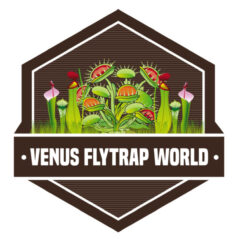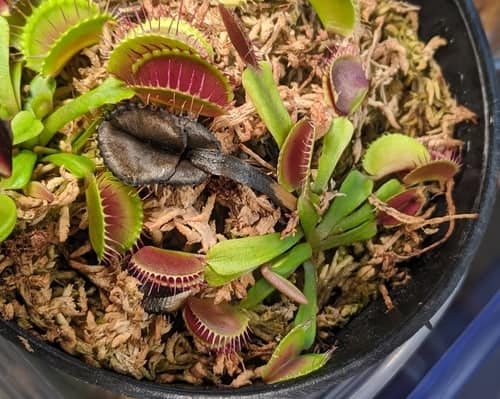Venus flytraps have developed successful snap trap mechanisms to capture prey. The leaves of the plant are sometimes open and sometimes closed. Their state can give you information about the plant.
Venus flytraps close their traps when they receive the appropriate stimuli. The trap closes when something touches the trigger hairs inside the lobes two consecutive touches within 20 seconds. The stimuli can be caused by humans, prey, rain, or falling leaves.
To properly care for a Venus flytrap, you must learn about their trapping mechanism. In this article, you will assess why your Venus flytrap has closed leaves and if it is healthy.
Why Is My Venus Fly Trap Closed?
Venus flytrap developed bug-catching mechanisms to supplement their diet. They generate their food through the photosynthesis process. But, because they natively grow in inferior soil, they must capture bugs to boost their nutrition.
The Venus flytrap exhibits snap trap mechanisms. The traps in the plant are modified leaves that look like jaws. Each trap is made up of two lobes. And each lobe has 3 thin filaments arranged in a triangular pattern. Those filaments are commonly called trigger hairs.
The picture below shows an open trap showing the trigger hairs. If you own a Venus flytrap, you should be able to spot them.
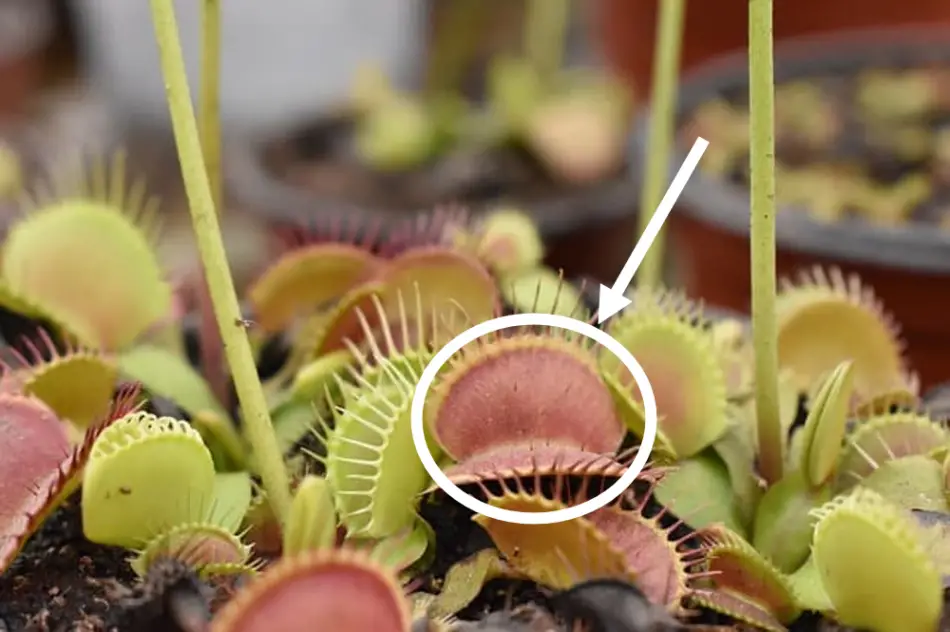
Venus flytraps spend significant amounts of energy controlling those traps. The plant must control its leaves with care and precision. The lobes only close when they received the appropriate signal.
Venus flytraps close shut only when something has stimulated their trigger hairs twice within 20 seconds. The plant developed a double-stimuli mechanism to prevent closing without capturing prey.
In the wild, Venus flytraps close when insects crawl or land inside their lobes. But also rain or falling leaves could stimulate the trigger hairs and make the trap snap shut.
Now, you know how to trigger a Venus flytrap to close. But, what about the leaves that are already closed? Are they consuming a bug? It is possible. For completion, I have made a list of common causes for a closed leaf. In each case, I explain when you should expect it to reopen.
Sometimes Venus fly traps won’t close their leaves to capture insects because they might be hibernating or sick. In this article, you can find more info on this: Why Venus Fly Traps Won’t Close Plus Easy Fixes.
The Venus Flytrap Is Consuming a Bug
The most common reason why Venus flytraps have closed leaves is that they have captured a bug. Outdoors Venus flytraps attract potential victims with sweet nectar and hope to catch a meal. Indoors, Venus flytraps can still capture bugs, but it is more unlikely. It all depends on access to bugs.
Against popular belief, Venus flytraps not only consume flies. They attract and capture a myriad of different insects or spiders.
The traps close when a curious insect encounters the trigger hairs twice within 20 seconds. Then, the trap snaps shut. The bug will likely try to escape and run around the trap. However, further stimuli to the trigger hairs will activate the enzyme production inside the trap. Finally, the leaf will start digesting the bug inside the leaf.
The digestion process for Venus flytraps is long. The trap remains closed for several days or even a couple of weeks during the process.
Once the plant is finished with the bug, the leaf reopens and exposes the leftovers from the prey. Venus flytraps can’t digest the exoskeleton.
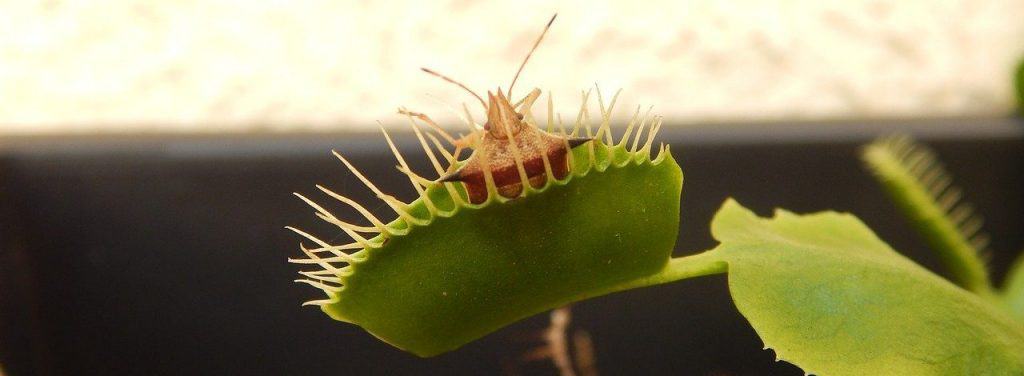
It Closed by Mistake
Even though Venus flytraps aim to prevent closing their traps due to a mistake, it can happen. Sometimes heavy rain can stimulate the trigger hairs. Or maybe a human was playing with the plant and closed the traps by poking them.
When a Venus flytrap is closed without a live insect inside its trap, the leaf will reopen in the next 24 hours. The plant does not start the digestion process without further stimuli. A dead bug or an empty trap won’t stimulate the trigger hairs any further.
It is not recommended to play with the traps of a Venus flytrap. The leaves can only open and close a couple of times before they wither. Triggering the leaves without bugs can harm the plant as it loses leaves, and it wastes energy.
If you own a Venus flytrap, place the plant strategically in a location where the leaves won’t get triggered. Put them away from curious pets and moving objects such as flowing curtains.
The Leaf Is Dying
Venus flytraps are always growing very quickly. They produce new leaves often as old ones wither. After opening and closing a limited amount of times, some leaves start to wither.
Sometimes a trap is closed, and due to its age, it starts to wither. In this case, the trap won’t reopen. It will remain closed and slowly dry up until it has completely blackened.
Do not worry about a leaf withering if it is an isolated event. Black leaves are commonly present on Venus flytraps. However, when you notice an increase in black leaves. You must assess the health of your plant. When leaves stay closed and wither, then it might be a sign of incorrect feeding. You can learn the details in this article: Venus Flytrap Feeding Guide. It is best to learn how to feed your plant before getting started. Incorrect feeding can harm the plant.
Why Are All My Venus Flytrap Traps Closed?
In some uncommon occasions, Venus flytraps might exhibit many closed traps. Usually, a couple of leaves might be closed, but not all of them.
The motion during shipping, potting or repotting can cause a Venus flytrap to close all or most of its traps. The plant won’t die due to the stress, but it will weaken.
If your plant has closed most of its leaves due to shipping, potting, or repotting, I have some advice for you.
Stress Due to Shipping
Owning a Venus flytrap is a unique experience. Some of us find carnivorous plants in farmer markets or gardening shops. Others order them online.
Shipping carnivorous plants is safe. Most carnivorous plant nurseries are highly specialized and know precisely how to pack a Venus flytrap. When ordering Venus flytraps online, consider choosing a potted option. Most vendors give you the opportunity to ship the plant bare-root or potted.
It is not a requirement, but potted plants tend to arrive with intact roots. The container, like enclosed in a dome or terrarium, prevents the leaves from damaging.
When receiving an online order, be extra careful handling the plant. Most of the traps might be closed due to the motion. Ensure you are at home when the plant arrives and remove it from the packing as soon as possible.
Do not worry about the closed leaves when the plant arrives. The most important thing to do is plant the Venus flytrap in appropriate soil, water it with the correct water source (distilled, reverse osmosis or rainwater), and provide proper lighting.
After introducing the plant to its new environment, avoid causing unwanted stress. Do not play with the traps, feed the plant, or fertilize it. Let it rest for a few weeks. By then, the traps will be open, and you can experience giving your plant a meal.
Contact During Potting and Repotting
Many leaves of a Venus flytrap can close during potting and repotting.
Potting and repotting a Venus flytrap can cause stress to the plant. Also, it is difficult for the owners to handle the plant without triggering some of the leaves. Generally, you should avoid touching the inside of the traps. But it is not always possible.
I struggle to repot the plant in the picture below. The Venus flytrap had outgrown the container. When transitioning it to a new pot, I activated multiple traps.
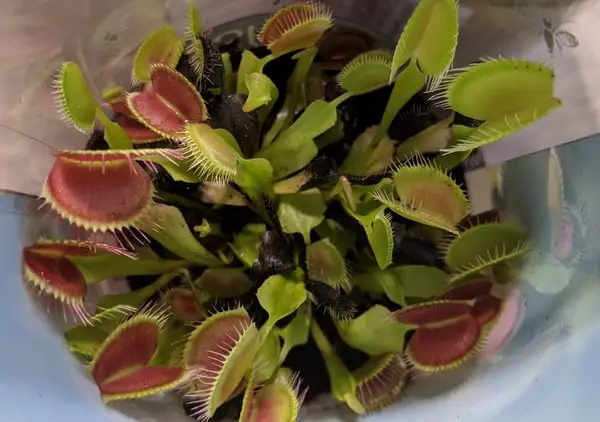
After potting or repotting a Venus flytrap, treat the plant with care. Avoid feeding it and avoid causing any additional stress. Place the plant in its set location and leave it there until it fully recovers. It usually takes only a few hours for traps to reopen. But, it takes a couple of weeks for the plant to adapt to new media.
You can learn all about the potting process in this article: Venus flytrap Potting and Repotting Guide. It can be tricky, but following the correct procedure sets you for success.
Final Thoughts
Owning a Venus flytrap is a challenge. Learning about how they work is a significant first step in understanding the plant’s requirements. This article gave you some brief information on feeding, playing with traps, stress, and potting. However, there is a lot more to learn.
I have made a Venus flytrap Care Sheet you can download as a PDF. The care sheet is in this article: Venus Flytrap Ultimate Care Guide. Best of luck growing Venus fly trap!
